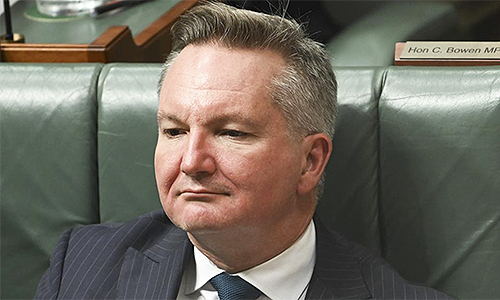
by JOHN MIKKELSEN – THE old cliché about how you can tell a politician is lying – their lips are moving – has never been more clearly illustrated than the tsunami of misinformation, disinformation and outright lies surrounding nuclear energy.
There should be a rational debate between the Coalition and Labor but with Opposition leader Peter Dutton pushing the need for modern reliable nuclear energy in our power mix, key Labor figures have replied with puerile memes of three-eyed fish.

- That is so far from the truth it would be laughable if it wasn’t so serious.
- Labor’s uncosted energy plan will cover an area the size of Tasmania with solar farms and wind turbines.
- The Coalition wants to establish seven nuclear plants at existing coal fired power stations marked for retirement.
More seriously, they are crying wolf about exorbitant costs and time frames which bear no relation to reality.
All it takes is a few mouse clicks to expose the lies.
FEED
The Coalition wants to establish seven nuclear plants at existing coal fired power stations marked for retirement, which would feed neatly into the existing power grid, while maintaining a mix of gas, solar and wind in the system.
Labor wants to rely solely on its rushed transition to unreliable renewables to achieve “net-zero” by 2050.
This will involve covering an area about the size of Tasmania with solar farms and wind turbines, including arable farmland, native forests and mountain ranges – as well as large areas offshore in whale migration routes.
Connecting all of these will require an additional 28,000km of new high voltage transmission lines – what could possibly go wrong?
Climate Minister Chris “Blackout” Bowen says Australia should “stick to the plan” regarding renewables and “not isolate itself from the rest of the world by embracing nuclear, the dearest form of energy, which would take too long to establish”.
That is so far from the truth it would be laughable if it wasn’t so serious.
According to the World Nuclear Association (WNA), nuclear is the world’s second largest source of low-carbon power (26 per cent of the total in 2020). There are 440 operable reactors, with 61 under construction.
NEWSFLASH!
More than 50 countries also utilise nuclear energy in 22 research reactors, which are also used for the production of medical and industrial isotopes, as well as for training.
Newsflash! Mr Bowen and PM Anthony Albanese, that would include the Lucas Heights nuclear reactor which has operated successfully since 1958, with an update by the Australian Nuclear Science and Technology Organisation (ANSTO) to an Opal Multipurpose reactor in 2007.
This is in the heart of Sydney. However, I’m unaware of any three-eyed fish or mutant koalas there, or citizens who glow in the dark unless they are setting off flares illegally on the steps of the Opera House in some pro-Hamas/Jew slaughter celebration while police watch on.
But I digress.
Back to big lie number two: Nuclear power plants take too long to build.
According to Statista.com, nuclear reactors connected to the grid in 2022 had a median construction time of 89 months or almost 7.5 years.
CONSTRUCTION
The longest median construction time for nuclear reactors was for those connected between 1996 and 2000, at 120 months.
The United Arab Emirates must be among countries much smarter than our leaders think we are because they have managed to establish three large reactors within this reasonable time frame. The UAE embarked upon a nuclear power program in close consultation with the International Atomic Energy Agency, with huge public support.
It accepted a $20b bid from a South Korean consortium to build four commercial nuclear power reactors, totaling 5.6 GWe, by 2020 at Barakah.
Unit one of the country’s first nuclear power plant was connected to the grid in August 2020, followed by unit two in September 2021, unit three in October 2022 and unit four in March 2024.
But as Bowen, Albo and other Labor luminaries claim, “nuclear costs a bomb” right? (oops, pretty obvious pun there guys, let’s keep Hiroshima and Nagasaki out of the equation).
Well no, according to the WNA, on a levelised (ie lifetime) basis, nuclear power is an economic source of electricity generation, combining the advantages of security, reliability and very low greenhouse gas emissions.
Existing plants function well with a high degree of predictability. The operating cost of these plants is lower than almost all fossil fuel competitors, with a very low risk of operating cost inflation.
RISKS
Plants are now expected to operate for 60 years and even longer in the future. The main economic risks to existing plants lie in the impacts of subsidised intermittent renewable and low-cost gas-fired generation.
Labor is quick to criticize the Coalition’s scheme as “uncosted” but has never stated the overall cost of its own heavily subsidised green energy transition, including truckloads of financial backing to private companies.
Albo obfuscated and dodged the question from Peter Dutton in the House this week, but an independent expert group, Net Zero Australia, claims it will be between $1.3 to $1.5 trillion.
ABC finance guru Alan Kohler recently had this to say: “As for Australia’s capital requirement, the outgoing head of the Net Zero Economy Agency, Greg Combet, told the National Press Club that ‘hundreds of billions of dollars will be needed to achieve net-zero in Australia by 2050’.”
And the rest…
In July last year, Net Zero Australia (a collaboration between the Melbourne University, Queensland University, Princeton and Nous Group) put the cost for Australia at $9 trillion by 2060, or hundreds of billions every year for 36 years…”
That makes nuclear seem a bargain.PC












If Kerry Packer was still alive he would build a coal fired power station right now and would be worshipped by 2030 !
The Labor and Unions scare campaign relies almost entirely on the well-publicised disasters at Chernobyl in the USSR way back in 1986 and Fukushima, Japan, in 2011.
In April 1986, the core of one of the four reactors at the Chernobyl nuclear plant in Ukraine melted down and exploded. It happened during the final years leading up to the dissolution of the USSR Communist government when virtually no money was being spent on maintenance of key infrastructure.
In March 2011, an accident occurred at the Fukushima Daiichi Nuclear Power Plant in Ōkuma, Fukushima, Japan. This accident was caused by the 2011 Tohoku earthquake and tsunami – the most powerful earthquake recorded in Japan’s history. It was not a failure of the plant itself.
Thirty people died during or very soon after the incident at Chernobyl. A further five died much later from cancer – but It’s unclear whether they were affected by radiation exposure. The USSR also allowed pasture to remain contaminated which adversely affected milk supplies likely leading to 15 deaths from thyroid cancer in later years.
Nobody died directly from the incident at Fukushima. However, in 2018, the Japanese government reported that one worker had since died from lung cancer likely as a result of radiation exposure from the event.
Since then, activists have blown out of all proportion the perceived dangers of nuclear energy, claiming these events caused hundreds if not thousands of deaths. Lies, lies lies!
The fact is, statistically, it is the second safest form of energy production after solar.
Quote:
More than 50 countries also utilise nuclear energy in 22 research reactors, which are also used for the production of medical and industrial isotopes, as well as for training.
Newsflash! Mr Bowen and PM Anthony Albanese, that would include the Lucas Heights nuclear reactor which has operated successfully since 1958, with an update by the Australian Nuclear Science and Technology Organisation (ANSTO) to an Opal Multipurpose reactor in 2007.
Recently the Albanese Union Labor Government approved a new replacement nuclear reactor for ANSTO at Lucas Heights Sydney.
However, in a world free of woke stupidity Australia being an exporter of high quality coal with hundreds of years of known reserves and even coal seams running out to sea along the East Coast that are too far out now to be extracted for profit and if I was the decision maker coal fired power stations would be kept generating and replaced when no other option with latest ultra supercritical boiler technology, lower emissions.
And Small Modular nuclear Reactor generator plants, Rolls-Royce kit 470 MW for assembly on site, build time 4 years (subject to unions being given the ABCC), price estimated each $5 billion.
In recent times US nuclear power stations (many of them operating) were cleared for 80 year operation with provision to extend to 100 years possible.
Wind and solar average 20 years operation and must be removed, replaced and dumped, recycling is not cost effective for most components.
Cost-benefit analysis based on all costs involved in wind solar hybrid system and transmission lines compared to 80 years of nuclear reactor technology generators really does not need much thought to realise the advantages nuclear offers.
I cannot extract a sensible answer to my question as to why a system of many technologies covering so much land area could possibly be superior to power stations, regardless of the heating used to produce steam for the generator steam turbines, at existing locations connected to the existing transmission grid.
And included in those technologies batteries to stand by ready for when needed to stabilise the grid until seperate generator plants take over. Wind intermittent and unreliable so wind turbines on average supply electricity 2.45 days in every 7.0 days being AEMO 35% of Installed Capacity rating. Solar under 20%.
Why not stick with power station generators?
For over 100 years the world’s largest interconnected transmission grid (SA TAS VIC NSW ACT QLD) has generated essential base load 24/7 and peak demand extra electricity as required. From 1960s Snowy Hydro Electric Scheme was commissioned to generate support as needed but dependent on water supply.
Changeover ageing due for or already retired coal burning power stations to nuclear reactor technology, zero emissions, fuel rods of enriched uranium not often replaced and can be recycled to provide extra life, and lower still when depleted radiation level. The rods or containers are then safely and securely placed in a nuclear waste dump in a remote area.
However, depleted uranium and before recycling was achieved is used to produce ammunition for armour piercing military purposes, very low radiation level.